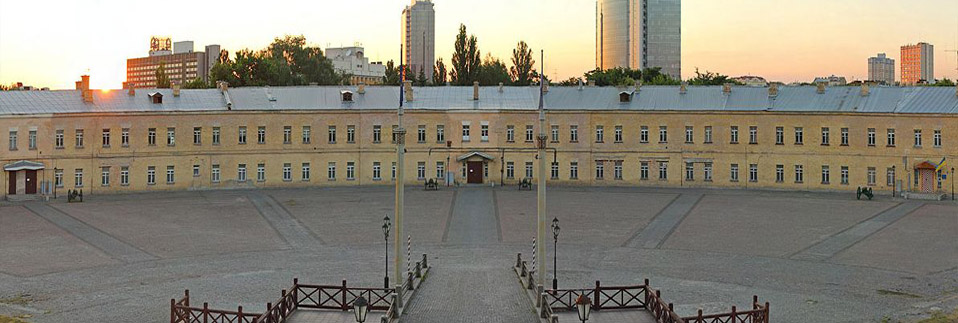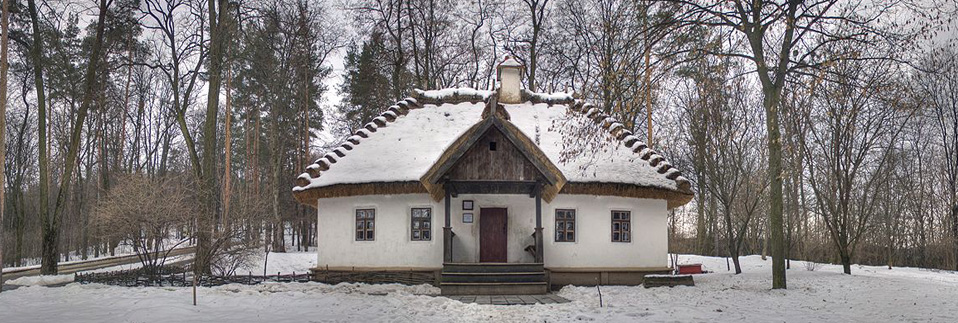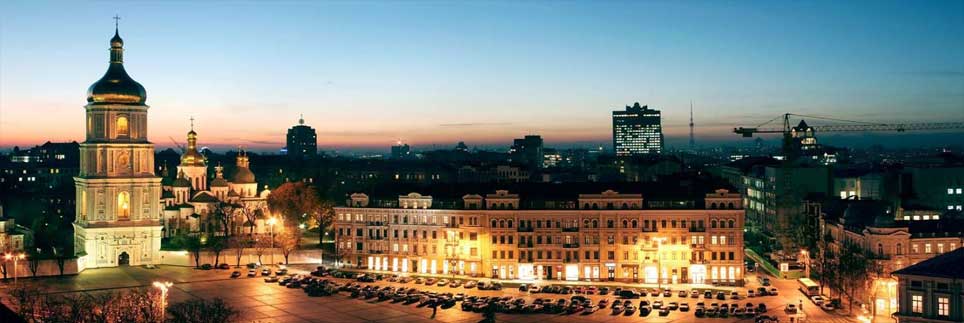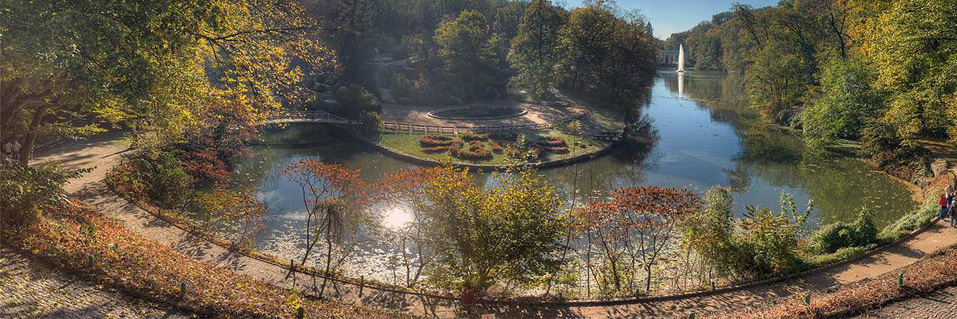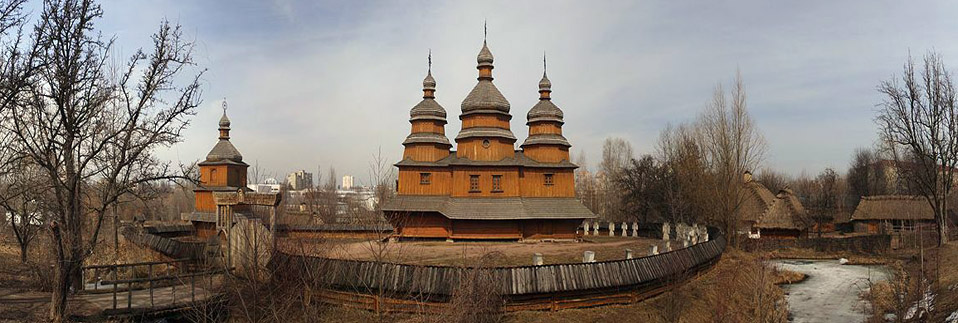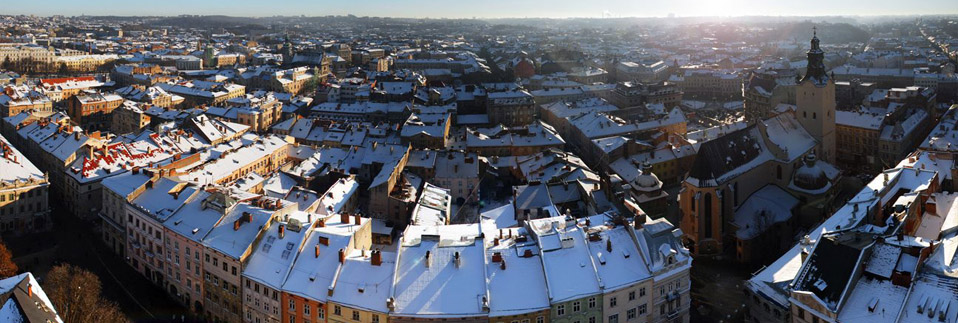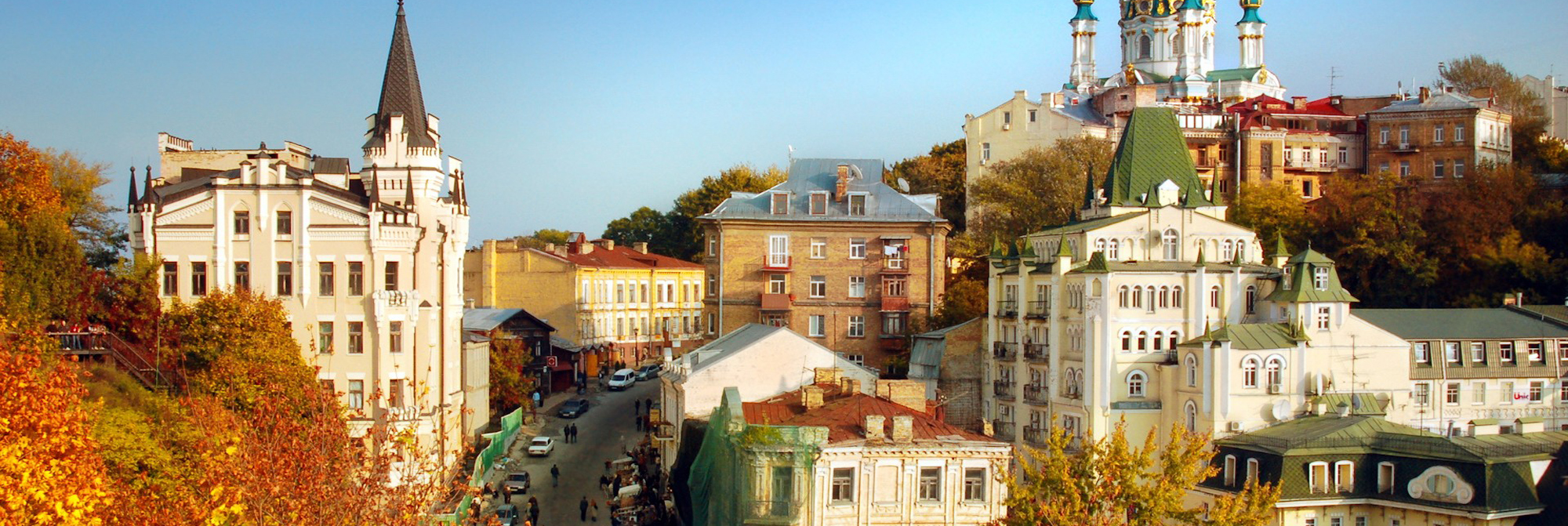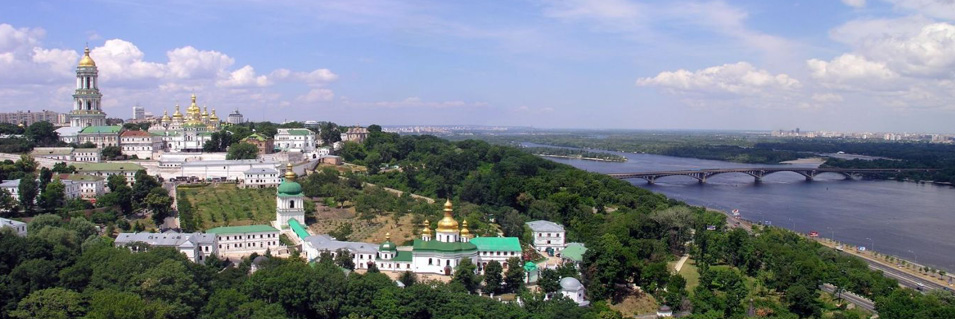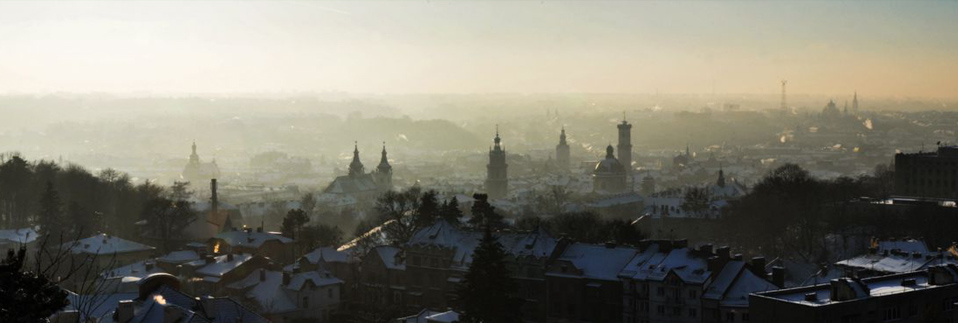Donetsk Region
Places for sightseeing and information about Donetsk Region
The history of Donetsk is eventful and full of contrasts. Started from small mine settlement, Donetsk has grown into a major administrative centre and a city of advanced industry, science and culture. The city has 1,131,700 inhabitants (2005); the metropolitan area has 1,566,000 inhabitants (2004). It is the fourth-largest city in Ukraine.
Donetsk sprang up and developed from a mining and metallurgical industry. In the upper regions of Kalmius river, where the city is located, there were large deposits of coal, and the first coal pits appeared around Cossack settlement of Alexandrovka, founded in 1779, that was on the site of present day Donetsk. In 1869 a Welshman, John James Hughes settled here and founded an ironworks that produced iron rails for the growing Russian rail network. Later steel rails were made.
The plant used coal from the immediate vicinity, and both coal mining and steel making branches developed rapidly. Alongside with the plant construction local men built wooden barracks and huts of sandstone for workers. The English colony for engineers and masters was set up separately. Arising settlement was named Hughsofka - Yuzovka in Russian – after the manager’s name (“Yuz" being a phonetic rendering of Hughes). Later, Hughsofka was merged with mining settlement Alexandrovka.
By 1874 Yuzofka metallurgic works ranked first in iron-casting among Russian metallurgical enterprises, thus transforming the South of the country into a major industrial region. Apart from iron- and steel-production, machine-building and coal-mining were significantly boosted. By the beginning of the XX c. Yuzovka had approximately 50,000 inhabitants and it attained the status of a city in 1917. After the October revolution (1917), in 1924 Yuzovka the city's name was changed to Stalino after Joseph Stalin. The Nazi invasion during WWII almost completely destroyed the city, which was mostly rebuilt on a large scale in 1950-1960-ies. During Nikita Khrushchev’s second wave of destalinization immediately after the 22-nd Communist Party Congress in November 1961, all Soviet cities named after Stalin were renamed.
The city got a new name of Donetsk after the Donets river, a tributary of the Don. The post-war modernization resulted in a considerable increase in the scale of industry. There are now more than 40 coal pits within the town limits. Major integrated coking, iron-smelting and steel-making plants make modern Donetsk one of the largest metallurgical centres of the Ukraine. Coke-by-products are the basis of a chemical industry producing plastics. There are several heavy-engineering works, which produce, in the main, mining equipment.
Today the city can’t boast for a tourist boom, it mainly attracts the foreign businessmen who are always welcomed with warm Ukrainian hospitality. Some new good hotels, restaurants and casinos have been recently built in Donetsk. On visiting them one can witness that local residents have learned to live in grand style. According to the statistics Donetsk has one of the highest standards of living in the region. When one visits Donetsk he must keep in mind that the city was born anew after the devastating years of WWII. One of the characteristic features of the architectural outlook of Donetsk is the abundance of monuments constructed in typical socialist style: symbolic monument to a miner that is called “Glory to the miners’ labour”; classic monument to Shevchenko; monument to the state and Bolshevik party leader Artyom that was a “must” to be unveiled everywhere in this area during the Soviet time.
Some new monuments appeared within the last 10 years: monument to the Olympic Champion and the holder of the world record in pole vaulting Sergey Bubka; a copy of the Tsar Canon was brought from the Moscow Kremlin; a column of Archangel Michael was presented to the city by Kiev authorities; monument to famous Ukrainian singer Anatoly Solovianenko who started his career in Donetsk. Bronze monuments to the founder of the city John Hughes and to the popular contemporary singer Kobson appeared not so long ago in the city. Do not miss a visit to the Opera and Ballet theatre, its company is one of the best in Ukraine.
The name of the Football Club “Shahtar” Donetsk is well known for the sport fans not only in Ukraine. “Shahtar” (the name derives from the Ukrainian word for "miner") team after winning the Ukrainian league in 2004 is involved in the UEFA Champions League matches. For the last years it is one of the top Ukrainian teams, it participates in UEFA Cup Championships, it is a winner of numerous international tournaments. The club is now owned by Rinat Akhmetov - the richest Ukrainian business oligarch.The Club has one of the best training grounds in Europe. The five star stadium, the only one in Ukraine, for 50,000 spectators will be opened in 2007.
The city has very active religious life, here all religious communities are represented – Ukrainian Orthodox, Roman Catholic and Greek Catholic, Jewish, protestant, Islamic. Waste heaps that encircle the city give Donetsk very special panorama. The city is very green and lightly-polluted for being a major industrial city. The residents say with proud that it is a “city of black coal and white roses”.
Sviatogorsk Assumption (“Dormition” in Russian and Ukrainian Orthodox terminology) is one of the biggest places of worship in Ukraine and an architectural gem of Donetsk region. It is located in the chalk mountains “Holy Hills” on the picturesque high right bank of the river Seversky Donets. Some historical documents testify that here, along the river, in the XVI c was the conventional border line between Russian lands and the Wild Field. The first written reference about a Cossack outpost that protected this land from the nomadic tribes is found in the chronicles of the XVI c. Probably the monastery appeared in the mid-XIII c. when some monks fled here from Kiev Cave monastery during the Tartar-Mongol devastating invasion.
Another version presumes that the monastery came to life much earlier when in the VIII-IX cc. the icon worshippers fled from Byzantium to Crimea and further to the North. According to the “Saints’ Lives”, about 860, here, on the lands that belonged to the Khazarian Kaghanate, Equal-to-the-Apostles brothers Cyril and Methodius imposed and consolidated the Christianity. In 1624 these lands were presented by the Tsarist Government to the clergy and a special Charter of immunity was presented to the monks. It was the most remote outpost in the South of Russia, practically beyond the state borders. For the next decades the monks carried on intensive construction of the temples but in 1679 the monastery was robbed and burned by the Crimean Tartars.
At the beginning of the XVIII c. the monastery was returned to life and quickly became a rich landowner. In 1787 Catherine II, carrying on her policy of secularization of the Church lands, closed the monastery. The property was passed to the State Treasury and in 1790 these lands were presented to Prince Grigory Potemkin. Under the pressure of the public opinion Russian Tsar Nickolas II returned these lands to the Church in 1844. The monastery was reopened under the name of “Sviatogorsk Assumption Pustyn” (Hermitage). It attracted thousands of believers and became the biggest one in the South of Russia. On the eve of the First World War in 1914 the Church officials even discussed the possibility to give the monastery the highest rank title – the “Lavra” title. But the fate was unmerciful to the monastery. A real bloody tragedy happened here in 1917-1918 when the Bolsheviks robbed, destroyed the monastery and murdered the supporters of the Church. In 1922 it was closed. The locality “Holy Hills” was renamed as “Red Hills”. The Church of Transfiguration was blown up and on this site on the top of a near-by hill a huge monument in the style of constructivism to the Bolshevik leader Artyom was erected in 1927. The name of Artyom was also given to the rest home for the workers organized on the grounds of Pustyn. During the German occupation the monastery resumed its activity but for very short time in 1942. In 1947 the graveyard church of All Saints was blown, and in 1960-ies all cemeteries were destroyed.
In the post-war years it was the main resort of Donetsk region. In 1950-ies the main Assumption cathedral was reconstructed as a cinema hall and the Refectory of the Nativity of the Virgin turned into a dining hall of the sanatorium. In the years of Perestroika the architectural complex of the monastery was proclaimed a national historical-architectural reserve and in 1992 the monastery opened again its doors to the believers. In 2004 the monastery was given the highest rank title of “Lavra”. Thousands of worshippers came here to witness the rededication of this sanctuary. The Monastery complex to-day includes: Assumption Cathedral, Cells and the hotel, walls and pavilions, Pilgrims’ pavilion, an underground passage in chalk of the XVII c., tower, Refectory church, Church of the Protection of the Virgin Mary, Church of the bell tower, Cave churches of Alexei, Antony and Feodosy and the oldest and the most famous one – the Church of St. Nickolas that dominates the monastery at the height of 70 metres above the river. St. Nickolas church stands on the top of the chalk cliff and is the only one of this type in the world.
The legend says that it was constructed secretly behinds a high wall. When the construction was finished the wall was disassembled and the believers were struck by the miraculous beauty of the church. Everybody who participated in its construction was thrown down from the cliff or bricked up in the caves to take away for ever the secret of its construction. The whole atmosphere is full of peace and the outskirts are heavenly fantastic.
108 km to the South and you are on the Azov Sea shore in Mariupol, the second biggest city of Donetsk region and the tenth biggest city of Ukraine with the population of 520,000. It creates 1/3 of the industrial output of the region and 8% of entire country. It is the rail road terminus and one of the biggest sea ports of Ukraine. Mariupol is an iron and steel centre with machine plants, chemical works, and shipyards. Steel, metal, rolled metal, iron, cast iron, hot and cold rolled plates, flask, ferroalloys and tubes are produced here. Coal, salt and grain are the chief exports. Two industrial giants, “Azovstal” (Azov steel) and “Ilyich Steel and Iron Works” are the leading enterprises of the Ukraine.
A very symbolic is the huge monument to the metallurgist that welcomes everybody on approaching the city along the highway Donetsk-Mariupol. Mariupol area also has favourable natural conditions for developing the agriculture and health resorts. In the XVI-XVII near the mouth of the Kalmius river there was a settlement of the run-away peasants that was often plundered by the Tartars, it was known under the name of Domakha. It was destroyed in 1769 during the Russian-Turkish wars. In 1778 this Cossack outpost got the name of Pavlovsk, but this name didn’t last long. In 1780 the Greek emigrants who came here in 1779 renamed it Mariupol that meant “City of the Seas” in Greek.
The Greeks also founded 23 villages in the immediate vicinity of the town. Catherine II issued a special mandate by which she guaranteed the settlers many privileges. They were granted equal rights with Russian citizens and a self governing status and tax exemption for thirty years. From 1810-1873 the district of Mariupol was “Greek governed” and until 1859 the settling of other nationalities in this area was prohibited. In 1882 the rail road connected Mariupol with Donbas area. In 1886-1880 a new cargo sea port was constructed – it was the second biggest after the Odessa port in the South of Russia.
Many foreign consulates appeared in Mariupol. The proximity to the Crimean Kerch ores and to the Donetsk coal stipulated the construction of big metallurgic plants in Mariupol. Pipe-rolling plant “Nikopol” and metallurgic plant of Belgian company “Russian Providence", built at the end of the XIX c., gave a big impact to the industrial development of this provincial city and soon it became an important metallurgic centre in the South of Russia. During two years of the Nazi occupation (1941-1943) the city got severe damages and all its architectural monuments of the past were lost. A tragic page in the history of Mariupol Greeks happened in April 1944. Following the order of Stalin, the Greeks together with representatives of other national minorities, were accused in collaboration with the Germans and deported to Uzbekistan.
Everything Greek was deliberately forgotten and even the name was changed. For more than 40 years (1948-1989) it was named as “Zhdanov” in honour of one of the Communist Party leaders. Only in 1990 the name of Mariupol was returned to the city. Today, the Azov region is home to the largest concentration of Greeks in Ukraine. The Greeks of Azov have managed to maintain their national identity and culture, while strengthening their ties with Greece and the Greek Diaspora throughout the world. The Greek society of Mariupol was established in 1989 with the aim to rebirth Greek culture and language among the Greeks of the Azov area. To-day it consists of 3320 members.
About the history of the city one can learn at the Regional Museum, the Museum of Local Lore with traditional for these lands Polovtsy stone sculptures and the Museum of Ethnography. Twenty five monuments from the Neolithic Age (VIII c B.C.) notably burial grounds have been discovered near Mariupol. There is also an Art Exhibition that bears the name of the famous Russian landscape painter Arkhip Kuinji (1842-1910) who was born in Mariupol in a Greek family. He lacked a formal education, but his eminent gift helped him to attain a notable success in art. His teacher at the St. Petersburg Academy of Arts was another Great Greek – famous marine painter Ivan Aivazovsky.
The richest collection of Kuinji canvases one can see at the Russian Museum in St. Petersburg and at the Tretiakov Gallery in Moscow. When you walk along the embankment you feel yourself in the resort area, and that is true. Mariupol and its environs are a climatic resort and the most favourite vacation spot not only for the city’s inhabitants. Many plants of the Donetsk region have here their rest homes, camps and sanatoriums.
The third biggest city of Donetsk region is Makeevka (Population 436,000) which is situated only some 15 km from Donetsk. It is an “Industrial gem” of the region and often is called “Donbas in miniature”. Everything that is produced in the region is produced in Makeevka: coal, coke, metal, pipes, special machinery and equipments for the mining industry. It is a city of developed culture, science and education.
The city was founded in 1690 on the grounds of the former Cossack settlements. In 1861 it became the centre of the Don Cossack military forces. When the coal deposits were found here, Dmitrievsk settlement was built in 1890. By 1917 it grew into a town, but only in 1931 it was renamed as Makeevka. At present its 4,000 enterprises give 10% of the total industrial output of Donetsk region. Among the biggest ones are: the “Makeevka coal group of enterprises” that consolidate 10 coal pits; the oldest in the city metallurgic plant that was constructed in 1899; and “Makeevka pipe producing” plant – the biggest in Ukraine producer of the cast-iron pipes.
Within the last 5 years big changes can be seen in the city. In 2000 the “Programme of the reconstruction and organization of public services and amenities” was adopted that envisages general plan of the city reconstruction and a special “Programme of the environmental protection and guarantee of ecological safety of Makeevka in 2001-2005” gave already positive results. For a highly developed industrial city Makeevka is a green city and it numbers more than 20 different monuments of architecture and history.
Only in Makeevka one can find the only one in Ukraine boulevard names after Mikhail Gorbachev. A memorial “To the miners who lost their lives in the mining pits” was unveiled in 2005. Everything about the city one can learn at the local Museum that has two departments – an Art Gallery and Museum of Local Lore.
Like everywhere in Ukraine there is a Monument to the Heroes of the Great Patriotic War of 1941-1945 and a monument to the Ukrainian boys who were killed in the Afghan war (1979-1989). 20 different confessions exist in Makeevka and its environs, among them: Ukrainian Orthodox, Armenian, Roman Catholic, Jewish, Protestants and Chrishnaites. One of the most attractive buildings is the Church of The Mother of God that was constructed in the XIX-XX cc. in Byzantine style. In March 2002 the Cathedral of St. George opened its doors to the believers.
47 km to the North from Donetsk and you are in the fourth biggest city of the region (population about 300,000). The first settlements came to life here at the beginning of the XVIII c. The runaway peasants and Zaporozhian Cossacks founded small settlements and winter forts along the Korsun river. At the beginning of the XIX the first coal storages were discovered and soon small mine pits covered the area. In 1897 the construction of the rail road started. A settlement for the workers was built and it was named after the engineer Gorlov who made a lot for its development.
Some years ago a monument to him was erected in town. In 1871-1874 a big coal mine (later it got the name of “Kochegarka”) gave the first coal. It was the biggest pit in the whole Donbas area, in 1879 more than one thousand people worked here. Next year machine building, alabaster, brick-baking and cement plants were constructed in Gorlovka. Each plant had its own village and soon they all merged into one big settlement. In 1879 a big storage of cinnabar was discovered, and in 1886 the first cinnabar mine and a mercury plant were built, this plant produced the first mercury in Russia.
In 1932 Gorlovka got a status of a town. In 1940 there were 10 big plants and 13 mine pits, 180,000 people lived here. To-day Gorlovka is a big rail road junction specializing in cargo transportation. The industry is represented by coal mining; ore concentrating factories; machine building plants that produce mining combines and equipment for the coal mines; chemical enterprises that are specializing on the production of different fertilizers and medicaments. Light and food industry is represented by meat and milk plants. The clothes factory “Gorlovchanka” on long-term contract makes for the USA customer of the American materials and using American patterns sports jackets and trousers for ladies. The visitors usually go to the local Museum of History and unique Museum of Miniature books. Art lovers will enjoy a visit to the Art gallery that is famous for its rare and the biggest collection of Nickolai Rerikh’s paintings
Some very important industrial giants that brought economic prosperity to the whole Donetsk region are disposed in Kramatorsk (100 km to the North-West from Donetsk; 222,000 inhabitants). In 1760-ies these lands were presented by Tsarist Government to Count Taranov who founded a village Petrovka on the banks of the river Kazenny Torets. In the 1860-ies a rail-road station and later a settlement under the name of “Kramatorskaia” were built here.
As history says, in 1870 its first enterprise, a distillery, was constructed. In 1778 Kramatorsk was already a big cargo railroad station. It began to attract local and foreign businessmen. In 1885 -1887 Edgar Adelman, the owner of the Belgian company “Shtertsers and Sons”, constructed here a lime and alabaster producing plant. It made a good start for the development of a heavy industry in Kramatorsk. The foundation stone of the machine building industry was laid in 1096 when a foundry, that was at the same time a machine building plant of “Fitsner & Gamper”, produced the first equipment for the local metallurgic enterprises and coal mines. In a short time its products got very high reputation and were of high demand all over Russia. In Soviet time the plant continued to work and exported its products abroad. To-day it is known under the name of “Starokramatorsky” (Old Kramatorsk) machine building plant.
In 1887 the Belgians constructed a plant that produced the fireproofing equipment. The Germans in 1892 put into operation one more big machine building plant. In 1912 a high capacity cement plant started to pollute the air in Kramatorsk. The biggest in the world machine-building plant was constructed in 1929-1934 – it produced the equipment for the open-hearth furnaces, the equipment for Dneproges, for all the biggest Soviet metallurgical plants. The equipment for the first Moscow metro lines was produced here too. Now it is “Novokramatorsky” (New Kramatorsk) plant. In 1932 Kramatorsk got a title of a town. In 1939 the population was 94,000. After the war more than 10 new big industrial enterprises were constructed.
An assembling of plant on utilization of hard domestic and technogenic wastes in Kramatorsk has been started. The industrial monsters of Kramatorsk are interesting by themselves. One can learn about the town’s history at a local Museum of History. Museum of Fine Arts has a collection of the canvases of contemporary local artists. Rather rare at our time is the Monument to the Heroes of Russian-Japanese war of 1904-1905. Very emotional are the monuments to the heroes of the Civil War of 1919 and to the soldiers who were killed in the Afghan War (1979-1989). Kramatorsk is the birth place of famous Ukrainian actor and film director Leonid Bykov, singer Yosif Kobzon and world chess champion Ruslan Pononarev.
Artyomovsk (89 km North East from Donetsk, population 117,000) is one of the oldest towns in the whole area of Donbas. In 1571 it was the biggest Cossack fort post in the South of the “Wild Field”. Its original name Bakhmut derives from the river Bakhmut - a tributary of Seversk Donets river. At the end of the XVII c. the salt reserves were discovered here and they were much richer than in the Tor lakes (Slaviansk). Many residents of Slaviansk moved here.
When Peter the Great learned about this rich reserves he ordered to construct here a wooden fortress to protect the salt evaporators from the Turkish raids. The fortress was the biggest one along the Southern borders of Russia. In 1705 the Tsarist government decided to transfer the salt mines to the possession of the state treasury and this act got an unexpected reaction of the local salt miners. The headman of the local workers Kondrat Bulavin arrested the tsarist messenger. It was the beginning of the uprising that inflamed the vast areas of the Don river and part of Slobodskaya Ukraine (“Slobodian” or “Slobozhanschyna” in Ukr.).
The uprising (1707-1708) was crushed and the Cossack towns and settlements were burned by order of Russian Tsar Peter the Great. Only by 1736 Bakhmut recovered and life returned to this town. At the end of the XVIII c. Bakhmut became the centre of Bahmut “uezd” (district) which was the second after Moscow “uezd” in territory. In 1874-1876 special prospecting proved that the local reserves of rock salt were the biggest in the world. Since that time only 2% of the reserves have been extracted. During the years of the Civil War Bakhmut area was turned into a constant battle field between the supporters and the opponents of the Revolution of 1917.
The Soviet power was finally established in the town on December 22, 1919. In 1923 it was renamed as Artyomovsk (Artyom was a party nickname of Fedor Sergeev, 1883-1821, the leader of the revolutionary uprisings in Kharkov and Donbas in 1917) On October 1941 the town was occupied by the German troops. In the first days the Germans drove together more than 3,000 people, robbed them and then bricked them alive in the underground quarries of the alabaster plant. In the post-war time on the place of this tragedy, which is now the territory of the “Sparkling wine” plant, the underground memorial - “The Weeping Wall”, was opened.
The Germans also organized in Artemovsk a camp for the war prisoners. The remnants of 3,000 people were found later on the camp grounds. On September 5, 1943, Artyomovsk was liberated by the Red Army. The history or Artyomovsk is reflected in its monuments. The central square of the town is decorated with the statue of legendary Artyom. Impressive is the Monument to the Red Army soldiers who defended Bahmut in the years of the Civil War in the central park. More distant history of the town is commemorated with the monument to the leader of the uprising Bulavin. Some old buildings can testify to the prosperity of Bahmut on the verge of the XIX-XX cc.
A unique underground church was built in the salt quarry at the depth of 120 m. It is worth to mention that world famous Russian composer Sergey Prokofiev (1891-1953) was born near Artyomovsk in a small town of Krasnoe. Among the major architectural attractions the first to rank is the wooden St. Nickolas Church (end of the XVIII c.) with a brick bell tower (1861) on the Bakhmutka river, the church was never closed in the Soviet era. Quite impressive is the new building of the Baptist praying house.
To-day Artyomovsk produces: salt, gypsum, fireproof clay, sand, rolled non-ferrous metals, fireproof materials, machinery, furniture, glass, clothes, medicaments, and famous Artyomovsk champagne. “Artyomovsk sparkling winery”, one of the Europe's largest in producing champagne in a traditional French bottle technology, was founded in 1950. It is the only one in the world sparkling winery located at the depth of 75-80 metres. The whole production cycle is concentrated underground in a special microclimate of abandoned alabaster adits. The conditions of the gypsum mines are ideal for sparkling wine and as the result – its quality may be compared only to the products of the world’s best champagne makers. The best wine raw materials are brought from Crimea, Odessa and Nickolaev regions.
The masterpieces of Artyomovsk champagne makers have repeatedly won prizes at prestigious international contests and exhibitions and enjoy greatest success among the connoisseurs of the noble beverage worldwide. Among the winners: “KrymSect sparkling wine white collection brut”, “White Brut Sparkling” and “Artyomovskoye Red Sparkling”. Sparkling wine has been successfully exported abroad to the countries with appreciation of the traditional beverage: Germany, Holland, Belgium, Switzerland, Austria, Luxemburg, Great Britain, Baltic States, Poland, the USA, Canada and Russia.
The road to Sviatogorsk goes through a town of Slaviansk (110 km from Donetsk). This small town with the population of 125,000 is a well known health resort. Its history started at the end of the XVI c. when the Tor salt lakes attracted numerous salt traders who came here and obtained salt by evaporation. In 1620-ies the salt-workers asked the Russian government to protect them from the plundering Tartar raids and in 1647 a Cossack fortress Tor (the name was given after a small river Torets) was constructed. In 1664 the first salt-work was built. Since the mid-XVII c. it was the centre of the salt-mining and salt industry. Till 1784 it was called Solianoy (Salt) or Tor, and in 1784 it was renamed.
In 1782 the salt evaporating was stopped when cheaper salt was brought from Crimea, but in 40 years the process was resumed. 1/3 of the population was engaged in salt production. Big annual fairs were organized here. In 1832 a military doctor Yakovlev started to treat the soldiers with local sulphide containing mud and it was the beginning of turning this town into a health resort. To-day people undergo a mud treatment at three sanatoriums that are specializing in curing the nervous diseases, blood vessels and movement organs. The industry is represented by the chemical and soda producing plants, technical ceramic plant, terracotta tiles factory and the pencil making factory, the only one in Ukraine and one of three in the CIS countries.


